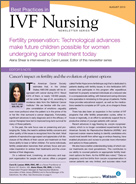The American Cancer Society estimates that, in the United States, 1,660,290 people will be diagnosed with cancer during 2013.1 About 8.9% of them, or nearly 148,000 people, will be under the age of 45, according to incidence data from the National Cancer Institute.2 We are familiar with the complex constellation of emotions – arguably even more profound when the patient is in the prime of his or her life – that surround a cancer diagnosis. Fortunately, significant advances in early diagnosis and in the efficacy of cancer therapies have led to improved long-term survival for many of these patients.
In the past, the sole focus was on preserving and prolonging life. Today, the need to address fertility concerns and other quality of life issues is recognized from the start.


